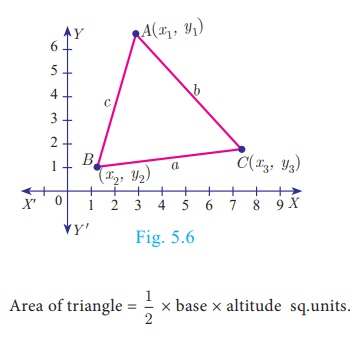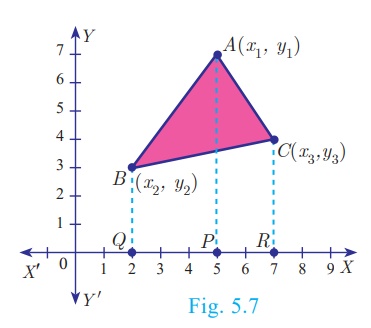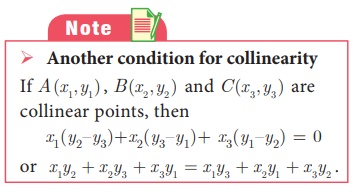Coordinate Geometry - Area of a Triangle | 10th Mathematics : UNIT 5 : Coordinate Geometry
Chapter: 10th Mathematics : UNIT 5 : Coordinate Geometry
Area of a Triangle
Area of a Triangle
In your earlier classes, you have studied how to calculate
the area of a triangle when its base and corresponding height (altitude) are
given. You have used the formula.

With any three non – collinear points A(x1
, y1) , B (x2 ,
y2 ) and C (y3 ,
y3 ) on a plane, we can form a triangle ABC.
Using distance between two points formula, we can calculate AB =
c , BC = a , CA = b . a, b, c represent
the lengths of the sides of the triangle ABC.
Using 2s = a +b +c , we can calculate
the area of triangle ABC by using the Heron’s formula  . But
this procedure of finding length of sides of ΔABC and then
calculating its area will be a tedious procedure.
. But
this procedure of finding length of sides of ΔABC and then
calculating its area will be a tedious procedure.
There is an elegant way of finding area of a triangle using the
coordinates of its vertices. We shall discuss such a method below.

Let ABC be any triangle whose vertices are at A(x1,
y1 ) , B (x2, y2
) and C (x3, y3 )
.
Draw AP, BQ and CR perpendiculars from A, B and
C to the x-axis, respectively.
Clearly ABQP, APRC and BQRC are all trapeziums.
Now from Fig.5.7, it is clear that
Area of ΔABC
= Area of trapezium ABQP + Area of trapezium APRC − Area of
trapezium BQRC.
You also know that, the area of trapezium
= 1/2 ×(sum of parallel sides) ×(perpendicular distance between
the parallel sides)
Therefore, Area of ΔABC
= 1/2 (BQ + AP)QP + 1/2 (AP +CR)PR
− 1/2 (BQ +CR)QR
= 1/2 (y2 + y1 )(x1
− x2 ) + 1/2 (y1 + y3 )(x3
− x1 ) − 1/2 (y2 + y3
)(x3 − x2 )
= 1/2 {x1 (y2 − y3
) + x2(y3 − y1 ) + x3
(y1 − y2 )}

Thus, the area of ΔABC is the absolute value
of the expression
= 1/2 {x 1 (y 2 − y 3
) + x 2(y 3 − y1 ) + x
3 (y 1 − y2 )} sq.units.

The vertices A(x 1 , y1
) , B (x2 , y2 ) and C (x3
, y3 ) of ΔABC are said to be “taken in order” if A,
B, C are taken in counter-clock wise direction. If we do this,
then area of ΔABC will never be negative.
Another form
The following pictorial representation helps us to write the above
formula very easily.

Area of ΔABC = 1/2 {(x 1 y2
+ x 2 y3 + x 3 y1
) −(x 2 y1 + x 3 y2
+ x 1y3 )} sq.units.
Note
“As the area of a triangle can never be negative, we must
take the absolute value, in case area happens to be negative”.
Progress Check
The vertices of ΔPQR are P(0, - 4) , Q(3,
1) and R(-8, 1)
·
Draw ΔPQR on a graph paper.
·
Check if ΔPQR is equilateral.
·
Find the area of ΔPQR.
·
Find the coordinates of M, the mid-point of QP.
·
Find the coordinates of N, the mid-point of QR.
·
Find the area of ΔMPN.
·
What is the ratio between the areas of ΔMPN and ΔPQR
?
Collinearity of three
points
If three distinct points A(x 1 , y1 ) , B(x 2 , y2 ) and C(x 3 , y3 ) are collinear, then we cannot form a triangle, because for such a triangle there will be no altitude (height). Therefore, three points A(x 1 , y1 ) , B(x 2 , y2 ) and C(x 3 , y3 ) will be collinear if the area of ΔABC =0.
Similarly, if the area of ΔABC is zero, then the three points lie
on the same straight line. Thus, three
distinct points A(x1,y1), B(x2,y2) and C(x3,y3) will be collinear if and only if area of ∆ABC = 0.

Related Topics